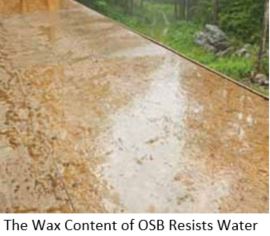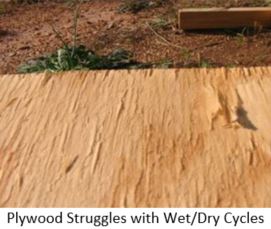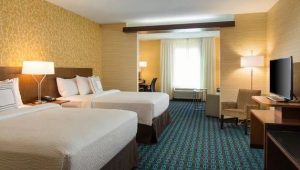Did you know that today, OSB dominates the construction industry for sheathing in new homes? Except for a few states in the northeast, its use far exceeds that of plywood for the construction of side walls, sub-floors, and roofs. It wasn’t always that way. OSB, when it first hit the market, was viewed as a cheap and inferior product. It took years to achieve its position of superior quality and market acceptance by quality builders throughout the country. The path of the modular home industry appears to be very similar to that of OSB.
OSB: A LITTLE HISTORY
 OSB, short for Oriented Strand Board, was first patented in 1965 and hit the market commercially in the 1970’s. It is manufactured from cross-oriented layers of thin, rectangular wooden strips compressed and bonded together with wax and synthetic resin adhesives. The adhesives are extremely resistant to moisture.
OSB, short for Oriented Strand Board, was first patented in 1965 and hit the market commercially in the 1970’s. It is manufactured from cross-oriented layers of thin, rectangular wooden strips compressed and bonded together with wax and synthetic resin adhesives. The adhesives are extremely resistant to moisture.
OSB, when it was invented, held great promise for the construction industry. It was cheaper than plywood and because of the way it is made, it has great mechanical properties making it particularly suitable for load-bearing applications in construction. The only problem was it needed time to mature as a product. When you unloaded it from your truck in the 1980’s, you needed gloves. The edges were prone to splintering. As it developed into the 1990’s, and with better binders and adhesives becoming available, OSB became even more resistant to moisture. And today, splintering is practically non-existent.
Particle board is different from OSB. However, because the two are similar they are easy to get confused. Particle board is wood and adhesives but the wood portion is typically saw dust. It is cheaper and used in economical construction projects. Up until recently it has still struggled with moisture issues. While OSB became a superior product, it suffered initially because of consumers, and even builders, confusing OSB with the lower quality particle board products.
OSB VS PLYWOOD DEBATE
 When OSB hit the market, some builders embraced it. It was a more cost effective product that had the required structural properties and allowed builders to provide a home at a better value. However, home owners thought it was cheap. OSB struggled to gain market share initially as it worked to improve quality and usability. Plywood, which is more expensive, also has its own issues with outdoor construction and the cycles of wet and dry as building on site exposed floors and roofs to multiple periods of rain and/or snow before it could be covered.
When OSB hit the market, some builders embraced it. It was a more cost effective product that had the required structural properties and allowed builders to provide a home at a better value. However, home owners thought it was cheap. OSB struggled to gain market share initially as it worked to improve quality and usability. Plywood, which is more expensive, also has its own issues with outdoor construction and the cycles of wet and dry as building on site exposed floors and roofs to multiple periods of rain and/or snow before it could be covered.
In 1990, OSB production was pegged at 7.6 billion square feet. By 2005, that figure had grown to 25.0 billion square feet. OSB had to gain market acceptance, and through improved building technology, its quality equaled or exceeded that of plywood. All of this at a much lower cost. And because OSB can be manufactured from lesser-quality trees and with less glue than plywood, it is just a better environmental option.
Currently, OSB represents 66% of total North American structural panel production. While it got a rocky start, OSB has proven its worth on multiple fronts making it the dominant sheathing product for roofs, floors, and walls. While there are those that still use plywood, the extra costs just aren’t justified when a structurally superior product is available at a lower cost.
OSB, MARRIOTT, AND MODULAR HOMES
 So, what was the turning point that brought OSB to its current market dominance? It turns out that during the 1980’s and early 1990’s contractors building multifamily homes started using it more and more. After all, there wasn’t a home owner involved with misconceptions about its strength and value. It was a better structural product that just made sense to use. Its popularity and use exploded with multi-family buildings such as duplexes, quad-plexes, condos and apartments. Once OSB won the battle of market presence in multi-family construction, it then quickly gained the market dominance it enjoys today across the residential construction industry.
So, what was the turning point that brought OSB to its current market dominance? It turns out that during the 1980’s and early 1990’s contractors building multifamily homes started using it more and more. After all, there wasn’t a home owner involved with misconceptions about its strength and value. It was a better structural product that just made sense to use. Its popularity and use exploded with multi-family buildings such as duplexes, quad-plexes, condos and apartments. Once OSB won the battle of market presence in multi-family construction, it then quickly gained the market dominance it enjoys today across the residential construction industry.
In 2016 Marriott Corporation, one of the largest hotel operators and franchisors in the world, decided to make the move to use modular construction for its hotels. Marriott can build up to 100 hotels in any given year. There is just no way to keep up that pace with today’s construction labor shortage. This is especially true if you are trying to build cost effectively and maintain a tight schedule. In the hotel industry especially, Marriott needs to have hotels finished, open and ready for booking rooms quickly. With the Marriott decision to use modular construction it can now deliver high quality hotels at a lower cost. And it does it in about ½ the time-frame it used to take.
RELATED: WHAT ARE FACTORY BUILT HOMES?
Modular construction has been used to build homes for years. A modular home isn’t exposed to the elements during its construction. Over the last several years creativity in modular homes has exploded. You can build practically any home style or design you want and do it very cost effectively. When you factor in the structural superiority of modular construction when building a home, with a process that creates less waste and is more energy efficient, modular homes just make more sense!
THE DESTINY OF MODULAR HOMES
Modular homes have been around for many years. During that time the modular construction method has matured into a superior way to construct a home. Just like with OSB, there have been some stumbling blocks along the way. Early on, the basic rectangular boxes were viewed as cheap alternatives to site built construction. A big hurdle has been the confusion of home owners, and even professionals such as real estate agents and inspectors, in knowing and understanding the difference between a modular home and a mobile/manufactured home.
After starting construction on several hotels using modular construction last year, Marriott is now showing many potential home buyers that stay in their rooms what a luxury hotel brand can create by exploiting the modular process. Perhaps modular homes have reached the turning point. In the next 10 years, modular homes could be the primary way a majority of homes are built in the U.S.





Comments(4)